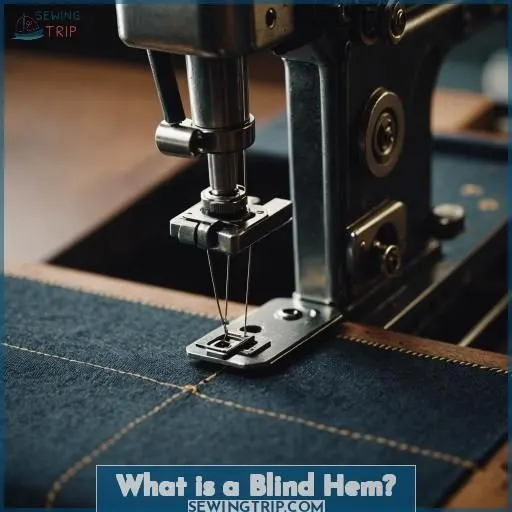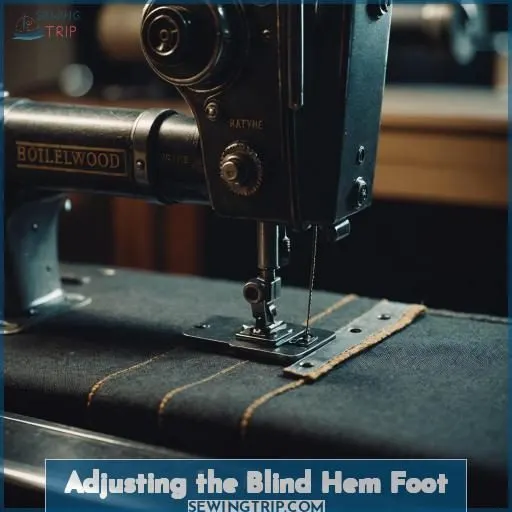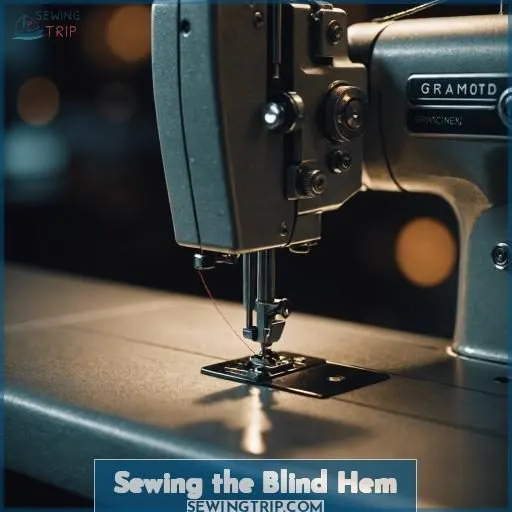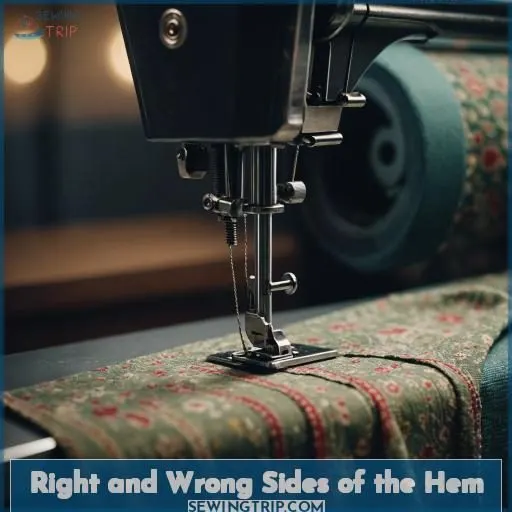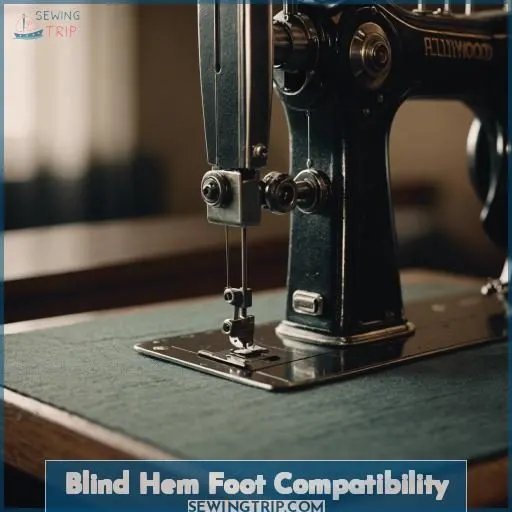This site is supported by our readers. We may earn a commission, at no cost to you, if you purchase through links.
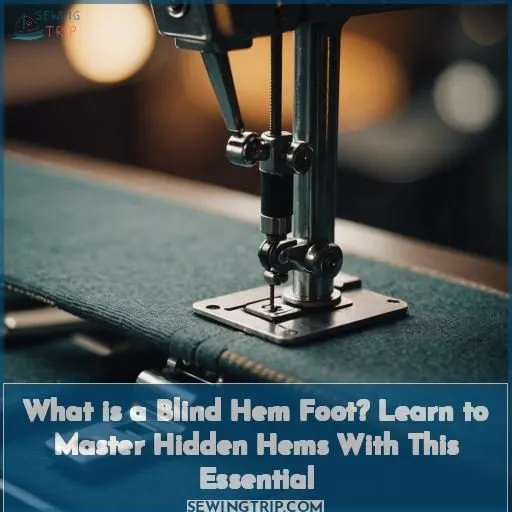 A blind hem foot is an indispensable presser foot that empowers you to craft professional-looking concealed hems. It boasts a metallic guide and grooves that safeguard accurate stitching, deter fabric slippage, and introduce slack into the upper thread tension – culminating in practically invisible stitches on the right side.
A blind hem foot is an indispensable presser foot that empowers you to craft professional-looking concealed hems. It boasts a metallic guide and grooves that safeguard accurate stitching, deter fabric slippage, and introduce slack into the upper thread tension – culminating in practically invisible stitches on the right side.
To perfect blind hems, this specialized foot is paramount. By adjusting its elements and adhering to the appropriate technique, you can realize a flawlessly finished garment edge.
However, there’s more to uncover if you yearn to truly master this invaluable sewing skill.
Table Of Contents
Key Takeaways
- A blind hem foot is a specialized presser foot with a metal guide in the center and grooves on the underside that help create nearly invisible hems.
- The metal guide ensures accurate stitching, while the grooves prevent fabric slippage and create slack in the upper thread tension for a smoother finish.
- Adjusting the blind hem foot’s components, such as the metal screw and plastic plate, is crucial for achieving perfectly aligned and secure blind hems on various fabrics.
- Mastering the blind hem technique involves carefully folding the hem, aligning it with the foot’s guide, and adjusting tension and stitch settings for a flawless, professional-looking concealed hem.
What is a Blind Hem Foot?

A blind hem foot is a specialized presser foot with a metal guide in the center and three grooves on the underside. It improves blind hemming accuracy, prevents fabric from slipping, and creates slack in the upper thread tension for an almost invisible stitch when blind hemming.
Components of a Blind Hem Foot
The blind hem foot is a specialized presser foot designed to help you achieve a flawless, nearly invisible hem. It features a few key components that make it ideal for blind hemming:
- A metal guide in the center to guarantee accurate stitching
- Three grooves on the underside to prevent fabric slippage
- A needle that swings over the guide, creating slack in the upper tension
Function of a Blind Hem Foot
The blind hem foot improves the accuracy and appearance of blind hemming.
It features a metal guide in the center that the fabric fold follows.
This ensures the needle only catches a small thread of the hem for an almost invisible finish.
The three grooves on the underside prevent slipping.
The needle’s swing over the guide creates slack in the upper tension for a smoother result.
What is a Blind Hem?
A blind hem is a sewing technique that creates an almost invisible finish, making it perfect for hems on trousers, skirts, and jackets. To achieve this, you’ll need matching thread and a specific stitch pattern.
- The blind hem stitch consists of straight stitches to the right and a jump stitch to the left, catching just a small amount of the folded fabric.
- The hem is folded twice and pressed, creating a clean, finished edge.
- This technique requires precision, as the jump stitches should be barely visible on the right side of the fabric.
- Marking the fabric and adjusting the stitch length can help guarantee the blind hem is perfectly aligned and secure.
- Mastering the blind hem takes practice, but the result is a beautifully finished garment with a hidden, professional-looking hem.
Adjusting the Blind Hem Foot
Now that you grasp the elements and purpose of the blind hem foot, it’s time to learn how to adjust it suitably for exceptional performance. This is a pivotal step to guarantee your blind hems emerge impeccably every time.
- Utilize the metal screw to shift the plastic plate and modify the location of the fabric guide.
- On some machines, you can also fine-tune the stitch width and needle position to refine the alignment.
- Precisely align the folded hem of your fabric with the plastic guide, making any required adjustments to align the jump stitches.
With a bit of practice, you’ll become proficient in adjusting your blind hem foot and create those aesthetically concealed hems that elevate any sewing endeavor.
Sewing the Blind Hem
To sew a blind hem, first prepare your fabric by pressing the hem and finishing the raw edge with a serger or zigzag stitch. Next, place the folded hem right side up on the right, and the main fabric wrong side up on the left. Fold the hem back over the main fabric, aligning the folded edge with the metal guide on your blind hem foot.
As you sew, the blind hem stitch will create larger jump stitches that catch the folded hem, while the smaller straight stitches will barely show on the right side. Adjust your tension to prevent the fabric from puckering, and make sure the folded edge stays aligned with the foot’s guide for an invisible finish. With a little practice, you’ll master this technique for beautifully hidden hems on woven and lightweight fabrics.
Right and Wrong Sides of the Hem
The right side of your hemmed fabric is where you want to see those delicate, nibbled stitches. This side faces outward, barely visible on the finished garment. The hem’s wrong side reveals the larger jump stitches holding everything in place.
Here’s a quick recap:
- Right side of hem = nibbled stitches
- Wrong side of hem = larger jump stitches
- Right side of fabric = visible on the hem
- Wrong side of fabric = visible on the main body
With the right fabric, needle, tension, and stitch settings, your blind hem will be a masterclass in disguise. Press the hem, align the folds, and let your machine work its magic.
Blind Hem Foot Compatibility
Touching on compatibility, you’ll be delighted to learn that the blind hem foot attachment is versatile enough to handle various fabric and machine types. It’s compatible with:
- Front-loading models like the 200130006
- Top-loading models such as the 820817015
- Stable medium-weight knits and stretchy fabrics
The key is using a screw-on or snap-on blind hem foot designed for your specific machine. Having the right foot guarantees the best stitch quality on different fabrics. For example, a snap-on foot may work better on delicate fabrics while a screw-on version excels with thicker materials. With a suitable presser foot type, you can confidently blind hem garments with expert results every time.
Frequently Asked Questions (FAQs)
What do you use a blind hem foot for?
You’ll use a blind hem foot to create an invisible hem stitch on garments like pants and skirts. It has a guide that helps neatly catch and stitch the folded fabric hem for a polished, concealed finish.
What is a blind hem?
A blind hem creates an inconspicuous finish by folding the hem twice and stitching it from the outside using coordinating thread. You’ll barely notice this hidden hem technique on skirts, pants, and jackets.
What is blind foot?
A blind hem foot guides fabric neatly while sewing invisible hems. Its metal guide allows the needle to swing over, creating slack for stitches that get hidden. You’ll find it handy for trousers, skirts, and jackets needing that professional, polished look.
Can you do a blind hem without a blind hem foot?
Yes, you can create a blind hem without the foot, but it’s more challenging. Use a zipper foot, align the hem edges precisely, and adjust your machine settings with great care for the perfect invisible finish.
What fabrics work best for blind hemming?
You’ll want lightweight or delicate fabrics like chiffon, linen, or silk. Thicker fabrics can work, but require extra care to get that crisp, invisible hem.
Can blind hems be machine washed?
Yes, blind hems can typically be machine washed! Just double-check the fabric’s care instructions, and avoid agitating washers for delicate items. The stitching’s low profile helps prevent snags or unraveling.
How to blind hem curved edges?
Use a blind hem foot with adjustable guide to follow curves. Go slow. Gently glide fabric around curves. Frequently check the hem is following your intended line. Re-crease folds as needed.
When should you not use a blind hem?
Sure, you could do a blind hem anywhere, but it’s not ideal for thick fabrics or curved edges. In those cases, a standard hem or hand sewing works better for a neat finish.
Tips for blind hemming thick or bulky fabrics?
For thick fabrics, you’ll want to use thinner needles and lengthen your stitch length. Go slowly, guiding the fabric with each stitch. With bulky materials, make shallow hems to prevent unwanted bulk.
Conclusion
Mastering the blind hem foot may appear intimidating initially. But with practice, you’ll discover its immense potential for creating pristine hidden hems.
Persist through any early challenges. The flawless, professional finish this tool facilitates is well worth the effort.
By adjusting its components accurately and adhering to the appropriate techniques, you can enhance your sewing abilities. You can produce garments with expertly concealed hems that showcase your proficiency.

